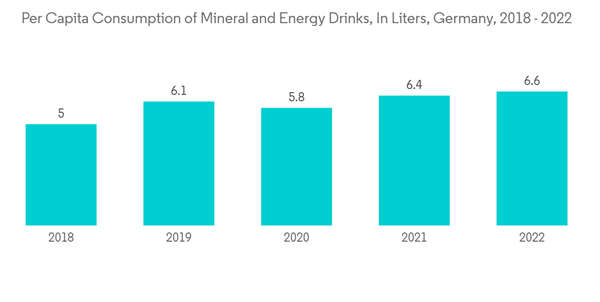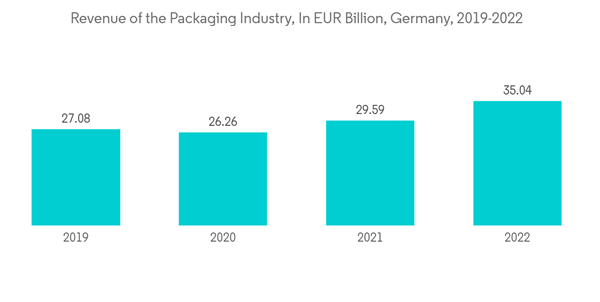Key Highlights
- The German packaging industry has seen a steady increase in the adoption of plastic packaging solutions in the domestic market due to the various developments made by solution providers and different end users in the country. The consumer's perception of "Made in Germany" goods has provided plastic packaging companies with a more advantageous operating environment. The German government has implemented several stringent regulations in the plastics packaging sector in Germany, such as the German Packaging Act, which requires packaging design to be recyclable and use recyclable or renewable materials. Furthermore, the government has set a target of recycling 63% of plastic packaging by 2022, a significant increase from the 40% recycled in 2018. These regulations are expected to significantly affect the studied market within the foreseeable future.
- According to the Office for National Statistics (UK), the amount of HDPE imported into the United Kingdom from EU and non-Eu countries has escalated significantly in the past few years. The HDPE imports from EU and non-EU during 2022 amounted to a whopping GBP 636.2 million (USD 809.3 million) and GBP 176.6 million (USD 224.6 million), respectively. Increased imports of HDPE mean a higher availability of the material for manufacturers in the UK and potentially other parts of Europe. This improved supply can contribute to the growth of the rigid plastic packaging industry by ensuring a steady source of raw materials.
- The market is also expected to experience significant challenges as regulatory standards constantly change. This is mainly due to the increasing awareness of environmental issues. In the region, the government has addressed the issue of plastic packaging waste and has implemented regulations to reduce the amount of ecological destruction and enhance waste management processes.
- Moreover, the Ukraine-Russia war also impacted the packaging market in the country. Russia banned exporting more than 200 products, including medical equipment and more. Tensions between Russia, Ukraine, and the West may inevitably affect global commodity prices, leading to a surge in recycling. Further, Switzerland recently stated that the prolonged dispute was pushing it to explore urgently stockpiling plastic granules for food packing.
Europe Rigid Plastic Packaging Market Trends
Beverage Segment is Expected to Witness Significant Growth
- In the beverage sector, packaging refers to technological innovations that extend the shelf life of products. Packaging interacts directly with the packaged product to remove residual oxygen, resulting in zero product permeation. By spreading the shelf life of beverage items that might otherwise degrade on store shelves or warehouses, this trend could save business expenses. PET is a reliable plastic for packaging direct-to-consumer products, especially beverages and food. It is comparable to glass in strength and flexibility but cheaper to manufacture and transport before and after bottling.
- The region is witnessing traction for sports drinks and has various leading brands such as Redbull, Monster, Isostar, and Lucozade, among others, who offer the product in plastic bottles. This increases opportunities for vendors in the market for plastic bottle packaging. Overall, the market is expected to grow steadily from other beverages' sales during the forecast period.
- The German beverage industry made around EUR 23.5 billion (USD 25.08 billion) in revenue in 2022, which was an increase of EUR 2 billion (USD 2.1 billion) compared to the year before, according to the Statistischen Bundesamt. As the beverage industry continues to grow, supply chains will likely need to be optimized to ensure products get to the consumer most efficiently. Plastic packaging, known for its strength and protection, could be essential in ensuring product integrity across the entire supply chain.
- According to the Federal Statistics Office (Bundesamt) statistics, in 2022, the average German drank about 6.6 liters of mineral and energy drinks. As the consumption of beverages increases, so does the need for packaging solutions. The rigid plastic packaging is often used for beverages because of its durability, lightness, and ability to maintain the freshness and quality of the product. As consumption increases, manufacturers and distributors will need more rigid plastic packaging to keep up with the market's growth.
Germany to Hold Significant Market Share
- The demand for healthy beverages is growing as consumers become more health conscious, and higher personal earnings have made bottled water more convenient for people. This is a driving factor for Germany's rigid plastic packaging industry growth.
- As now mandated by the EU Plastics Strategy, the German PET industry has been cooperating along the entire value-added chain for years. The sector encourages the creation of new beverage bottles from recycled PET. In Germany, 97 percent of single-use PET bottles are recycled through deposits, and 95 percent have lids.
- Current growth categories in alcoholic beverages include craft beer variations such as pale ale, wheat or lager beer, and alcohol-free beers. Asian beer brands are also gaining popularity and growing in Germany. Changes in consumer preferences have also led to higher consumption of organic wines, beers, and spirits.
- Many brands embrace higher sustainability standards due to consumer influence and growing legislation to encourage recycling. To cater sustainable solutions to such significant brands, packaging manufacturers are developing sustainable solutions. For instance, in October 2022, Sidel launched the 1SKIN, a label-less recycled PET bottle. The company introduced this bottle for the booming market in sensitive juices, teas, and flavored drinks. The new 1SKIN concept represents a breakthrough in sustainability and its streamlined design.
- The German packaging sector generated revenue of more than EUR 35 billion (USD 38.35 billion) in 2022, according to Statistischen Bundesamt. This figure significantly increased from the previous year's revenue of EUR 29.6 billion (USD 32.43 billion). As the packaging sector expands, manufacturers in the rigid plastic packaging market may diversify their product offerings to cater to different industries and consumer preferences. This could lead to specialized rigid plastic packaging solutions for various applications, such as food and beverages, pharmaceuticals, consumer goods, and more.
Europe Rigid Plastic Packaging Industry Overview
Rigid plastic packaging is a highly competitive market. Some of the most prominent players in rigid plastic packaging are Berry Global Inc., Amcor Group GmbH, Alpla Werke Alwin Lehner GmbH & Co KG, Silgan Holdings Inc., Seal Air Corporation, Plastipak Holding, Inc., and Sonoco Products Company, among others.In July 2023, Berry Global created a range of reusable bottles made entirely out of post-consumer recycled (PCR) plastic for UK ethical cleaning company The Bio-D Company. The range covers several bio-D liquid products such as laundry soap, fabric conditioner, dishwasher detergent, rinsing aid, washing up liquid, and garden cleaner, which includes 750 ml, 1litere, or 5 liters.
In February 2023, Berry Global Healthcare announced the launch of a comprehensive bundle solution designed to assist customers in capitalizing on the growing need for child-resistant packaging for pharmaceutical and herbal markets for syrup and liquid medicinal products. The new Berry Healthcare bundle consists of seven ranges of twenty-eight-millimeter neck PET bottles, ranging from twenty-five millimeters to one thousand millimeters in size, and is available in a variety of designs. The packaging includes eight accompanying closures, each of which is designed to provide tamper-proof and child-resistant capabilities.
Additional Benefits:
- The market estimate (ME) sheet in Excel format
- 3 months of analyst support
This product will be delivered within 2 business days.










